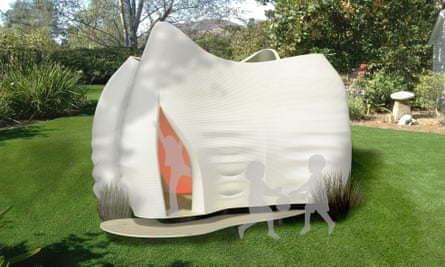Attendees at this year’s Melbourne International Flower and Garden Show in March are in for a surprise. No, not the usual prize petunias or gigantic geraniums. Natural beauty is two a penny here. Instead lucky ticket-holders will witness the unveiling of something entirely man-made – yet, not: a 3D printed treehouse.
The autonomously produced Kooky Cubby is the brainchild of a five-member consortium of Australian architects, engineers and robot designers. The precise design remains a tightly kept secret but the plastic molded cubby is known to draw on 3D printing technology developed by the Architectural Robotics Lab at RMIT University.
If it’s now possible to print a treehouse, are full-on printed houses just a matter of time? In the age of the so-called fourth industrial revolution, can we expect to see huge 3D printers on our building sites rather than armies of brickies?
John Hainsworth sees no reason why not. Digital leader for the built environment at engineering firm Aurecon (one of the partners on the Kooky Cubby project), he points to a variety of early experiments around the world: 3D printed concrete houses in China, a low-income “contour crafted” building design in California and a fully functioning office in Dubai.
“If it doesn’t need to be a thing of beauty and it just needs to be rapidly produced, then it’s only a matter of time before it [3D printing] is seen to be viable,” says Hainsworth, who is based in Sydney.
The Wasp project is embarking on just such a mission. Led by the Italy-based 3D printing firm Centro Sviluppo Progetti (CSP), the initiative has set its sights on printing houses in situ using materials from the immediate area. As a first step, it has built a 12m high, solar-powered 3D printer that uses water, vegetable fibre and soil to build a basic adobe-like structure. CSP is planning to use the Big Delta printer to build an experimental eco-village in an industrial zone in Massa Lombarda, an Italian town near Bologna.
WASP’s spokesman, Maurizio Andreoli, sees the zero mile house concept as a potential solution to the shortfall of robust, affordable housing in the developing world. “Our dream is a house for everybody,” he says. “We can replace slums with natural houses, which don’t leave waste when they aren’t used any more.”
Another 3D printing construction project that has generated a great deal of excitement is a proposed steel bridge in Amsterdam. After several years of experimentation and testing, the Dutch robotics firm MX3D hopes to start manufacturing the horizontal-structured bridge in the next couple of months.
Tim Geurtjens, the chief technology officer at MX3D, sees the bridge primarily as a proof-of-concept project: “We are going to see if the bridge is possible – not to show that this is the new way to construct a bridge but to demonstrate what the possibilities are and then people can use their imagination to come up with new ideas.”

Where those ideas might lead, no one is quite certain yet. A mitigating factor is obviously the technology. Although powder-based additives and resin 3D printing is well advanced in the manufacturing industry, advances with construction-ready materials are still early stage.
Regulation is another major hurdle on the road towards autonomously built houses. Standards for conventional building materials have been honed over the decades to ensure our built environment is safe and dependable. With no track record, the novelty of 3D printed materials makes regulators extremely jumpy.
“If you are talking about printing a public house or building, you have to demonstrate that it will hold,” notes Clément Moreau, the chief executive of the French cloud-based 3D printing firm Sculpteo, which launched a new titanium printing service earlier this year. “This regulation is very problematic ... everywhere that we want to put 3D printing, we have to face the regulation issues.”
Stewart Williams at the University of Cranfield is a pioneer in the metal printing technology used for the Amsterdam bridge. His team has just printed a 6m space-grade aluminum spar for the wing of a plane that could easily be repurposed as a girder for a building.
He too admits that quality control represents a major challenge. To be viable, any printed building technique will have systems that can constantly monitor and inspect the materials as they are being produced. As he notes wryly: “You wouldn’t want to build a massive beam and get to the end and find you’ve got some holes in it.”
Assuming regulators can be convinced, the potential upsides of 3D printing for the construction industry could be huge. Among the factors in the technology’s favour are productivity gains, reduced labour costs and safer working environments, as well as the sort of one-off, complex building designs that are not technically and economically feasible at present.
Still, no one in the industry (as yet) seriously envisions 3D printing displacing traditional construction techniques or relegating building firms onto the scrap heap. The most likely scenario for the near future is that 3D printing will be used to make specific building components, not the whole building itself. Whether these be small bespoke electric sockets or girder brackets, or larger-scale floor panels or entire walls remains to be seen.
3D printing’s disruptive potential comes to the fore when the technology is viewed in the context of other emerging innovations in the building sector. So, argues Dominic Thasarathar, head of thought leadership for the construction industry at the Nasdaq-listed tech company Autodesk. Top of mind for Thasarathar are developments in robotics and digital prefabrication.
“Much of construction is going to be moved into the factory … allowing you to make a better-quality product, in a short time frame, in a safer environment,” he says. “The technology now exists to make building components in very automated ways, such as robotic welding machines and robotic shuttering to make molds that you pour concrete into to make floor plates.”
He concedes that it could be economically viable to shift component manufacturing on site for very large building projects. In the short-term, however, 3D printers of the scale and sophistication required are likely to be too expensive for average contractors. Instead, he anticipates leasing companies to branch out into 3D printers and other cutting-edge automated machinery as the technology evolves.
As for the skills required, tomorrow’s building engineers and architects will ideally need to master the software programming skills on which 3D printing rests. Learning to co-work with automated technology will be an increasingly important requirement for the welders, masons, bricklayers, carpenters and other workers who physically build our houses and offices too.
Don’t expect widespread redeployment in the sector just yet, however. As MX3D’s Tim Geurtjens concludes: “Some jobs will be completed much more efficiently by robots than by people, but you always need skilled craftsmen on the spot. The one thing you can’t teach a robot is to be creative.”

Comments (…)
Sign in or create your Guardian account to join the discussion